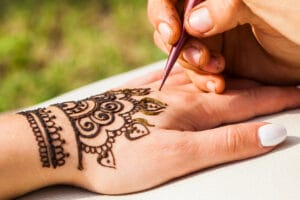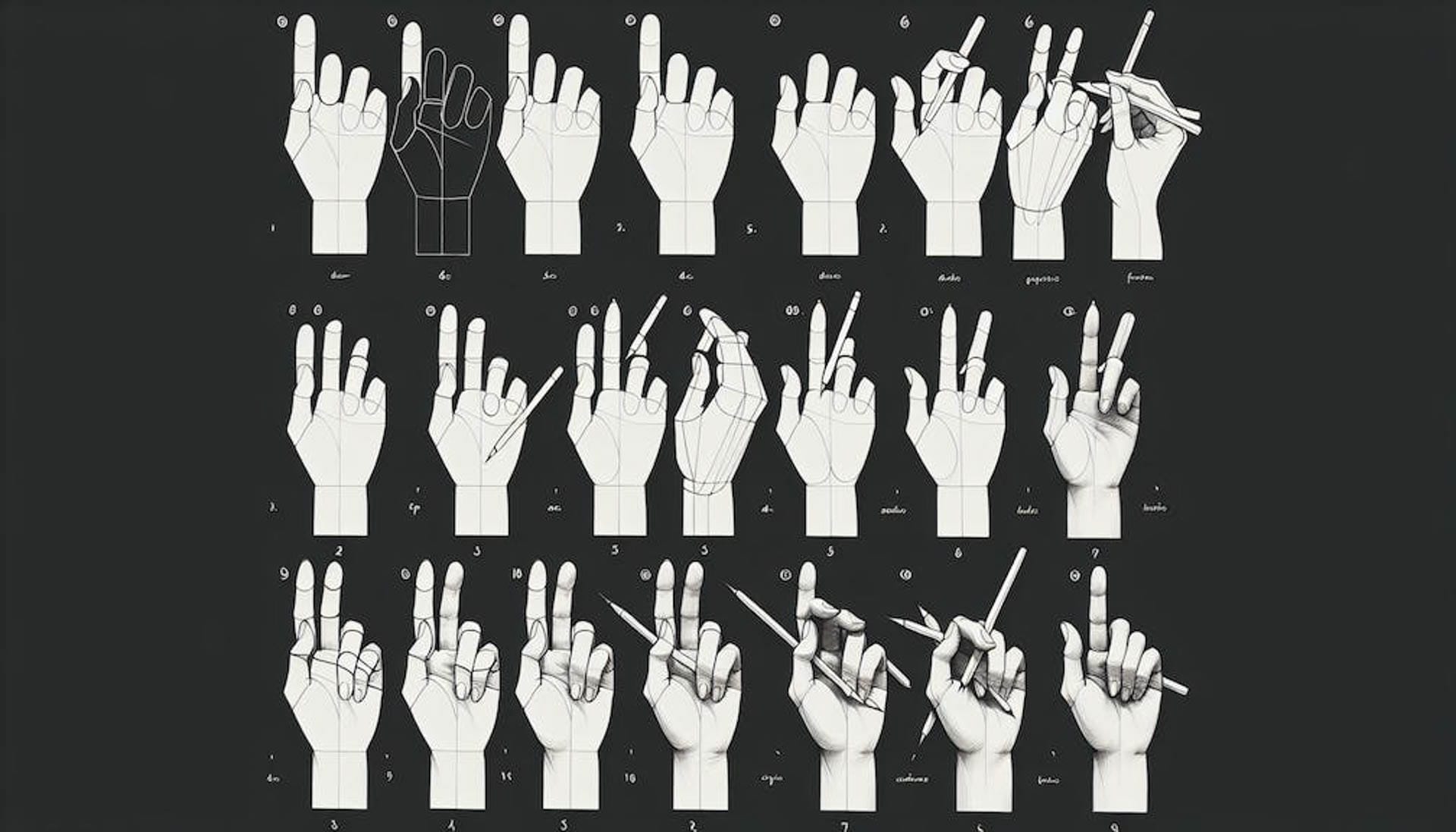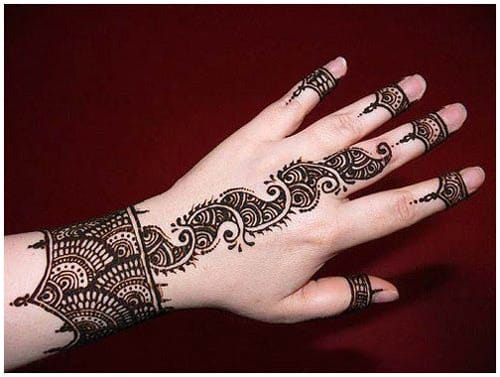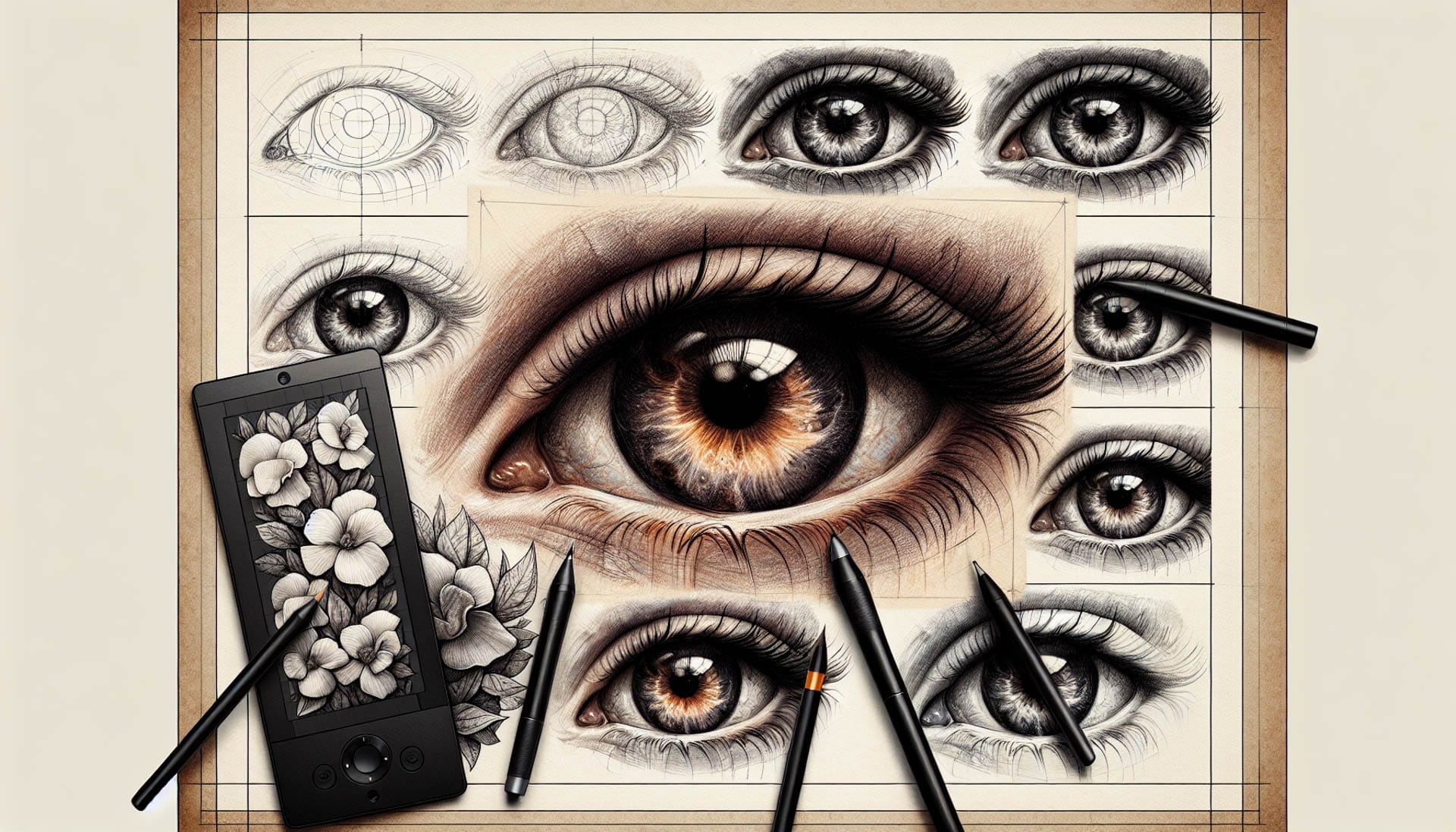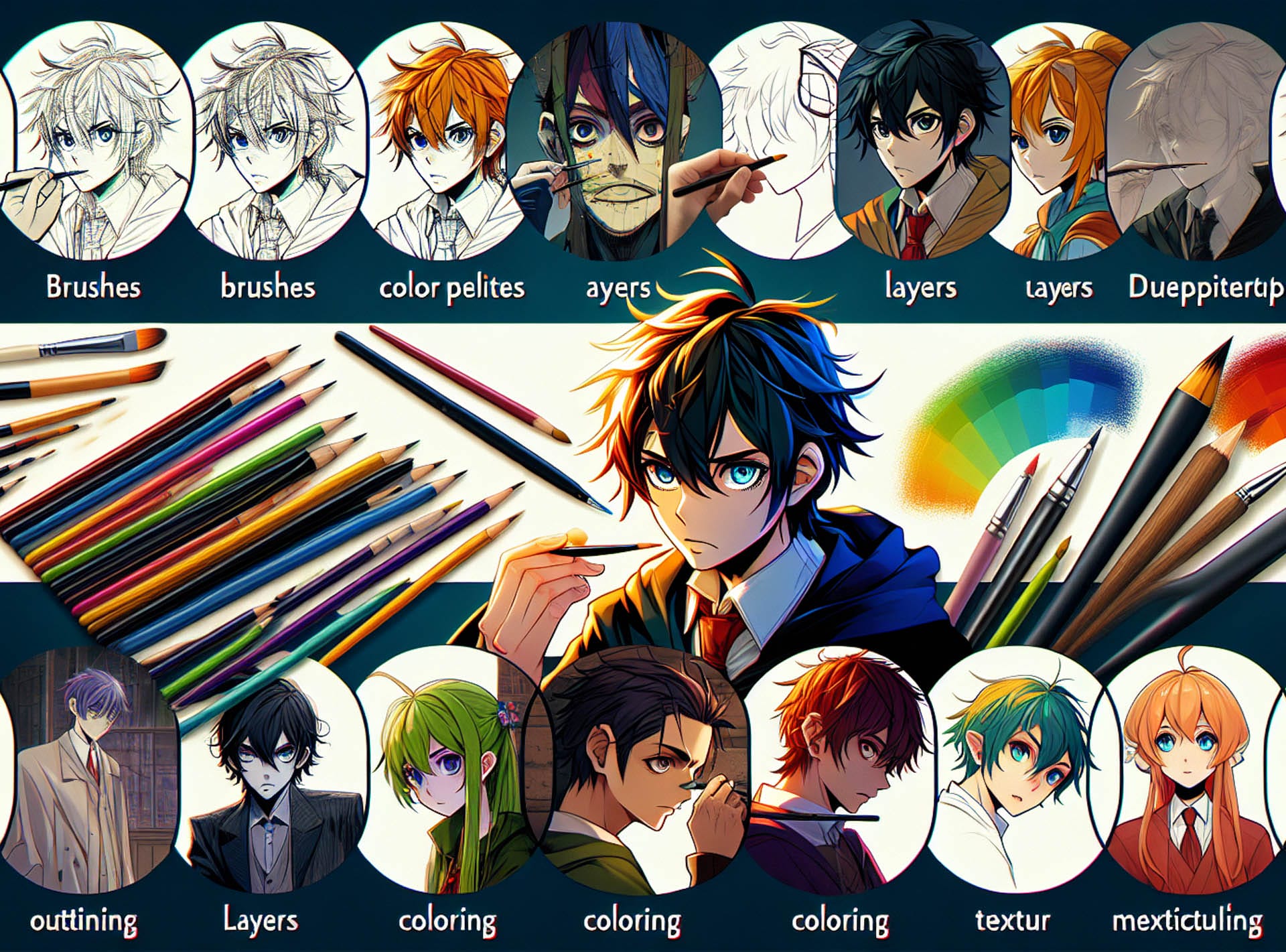Henna tattoos, with their delicate lines and mesmerizing patterns, are far more than mere temporary adornments; they are a journey into the heart of ancient artistry. Rooted in tradition, these designs possess a timeless allure that continues to captivate people across generations. Each delicate line and curvaceous motif tells a story of the artist’s skill and creativity, a story that unfolds with every stroke of henna.
Introduction: The Beauty and Art of Henna Tattoos
- Mehndi designs are a beautiful form of wearable art that has a long history dating back to the Bronze Age. They hold cultural significance in various traditions and celebrations around the world.
- Using henna for temporary tattoos involves creating a henna paste and applying it to the skin. The staining process creates intricate designs that can be customized based on personal preferences and cultural inspirations.
- Designing henna hand art is a creative project that starts with tracing your hand and choosing motifs and patterns. Tips and techniques can be used to draw intricate and stunning henna hand designs.
Five Facts About Henna Tattoos:
- Henna tattoos are a form of temporary body art that uses a dye made from the henna plant.
- Henna tattoos have been used for centuries in various cultures, including in India and the Eastern Mediterranean region.
- The designs for henna tattoos are typically intricate and feature patterns such as flowers, paisley, and geometric shapes.
- Henna tattoos are applied to the skin using a cone-shaped funnel, and the dye must be left on the skin for several hours to properly stain it.
- Henna tattoos are a popular form of body art for special occasions, such as weddings and festivals, but they have also gained popularity as temporary tattoos in Western countries.
Each henna tattoo is potentially a masterpiece in its own right, with the artist’s skill and creativity shining through every delicate line and intricate pattern.
When it comes to the realm of body art, few creations can capture the imagination as remarkably as henna tattoos. Their intricate designs can exquisitely blend cultural symbolism and personal flair.
Henna: From Bronze Ages to Modern Day
Throughout history, henna has been an integral part of various cultures, carrying deep cultural significance and traditions. The origins of henna can be traced back to the Bronze Age, where it was already used for adornment purposes. From ancient civilizations to modern-day practices, henna has evolved and spread across continents, leaving its mark on different societies.
The Origins of Henna and its Cultural Significance
The origins of henna can be traced back to ancient times when it held immense cultural significance. Henna has been a symbol of beauty and celebration in various cultures across the globe. Throughout history, henna has been used for various purposes, including body adornment, healing rituals, and religious ceremonies. Its rich cultural significance can be seen in its use during occasions such as weddings, festivals, and other important events.
Henna holds a special place in different cultures, representing love, happiness, and prosperity. Its intricate designs have become a form of artistic expression that transcends borders and brings people together. Understanding the origins of henna and its cultural significance allows us to appreciate the artistry behind this ancient tradition.
By embracing henna tattoos, we can connect with diverse cultures and celebrate the beauty of this unique form of body art. Don’t miss out on experiencing the transformative power that henna tattoos can bring to your life.
Visit this post to learn more about the details of the process: How to Use Henna: Applying a Temporary Tattoo – Then, get ready to unleash your inner artist and stain your skin with the power of henna, because it’s time to create some temporary tattoo magic!
Henna Tattoos Around the World: Cultural Traditions and Celebrations
As we dive into the vibrant world of henna tattoos, we discover the rich tapestry of cultural traditions and celebrations they are a part of. It’s fascinating to explore how henna is intricately woven into the fabric of various societies around the globe. We’ll take a closer look at henna’s significance in Indian weddings and festivals, where its intricate patterns symbolize joy and auspicious beginnings.
Henna in Indian Weddings and Festivals
Henna plays a significant role in the sacred rituals and vibrant celebrations of Indian weddings and festivals. The art of adorning hands and feet with intricate henna patterns has been a cherished tradition for centuries. Henna symbolizes beauty, auspiciousness, and love, making it an essential part of these joyous occasions.
During Indian weddings and festivals, henna artists create stunning designs on the palms, hands, and feet of the bride and other women in attendance. These designs often showcase intricate motifs inspired by nature, such as floral patterns, paisleys, peacocks, and sacred symbols like Om or Ganesh. Using henna is not just a way to express yourself, but it’s also believed to bring good luck and mark the beginning of a new chapter in life.
In addition to its cultural significance, henna’s natural dye properties create beautiful deep reddish-brown stains on the skin. This temporary body art lasts for about one to three weeks, enriching the festivities even after they are over. Women eagerly gather around during ceremonies to apply henna together while sharing laughter, songs, and stories.
One such enchanting story tells us about Anjali’s wedding day. Anjali was adorned with breathtaking bridal henna designs that symbolized prosperity and love. Friends and family painted her hands with mesmerizing patterns as they sang traditional wedding songs. Throughout the ceremony, Anjali couldn’t help but admire her intricate henna artwork that reflected her excitement for the journey ahead. Overall, henna’s presence in Indian weddings and festivals goes beyond just body decoration; it represents cultural traditions, auspiciousness, beauty, love, and camaraderie among women.
Wearable art reminds us of our rich heritage and lets people express their creativity. While henna in Western countries gives people a chance to rock a tattoo without any commitment issues.
Henna as Temporary Body Art in Western Countries
Henna has gained popularity as a fashionable and temporary form of body art in Western countries. People are embracing the beauty and creativity of henna tattoos, using them to adorn their bodies for various occasions and celebrations.
- Henna as a Fashion Statement: Individuals in Western countries are increasingly using henna as a way to express their personal style and fashion sense. They see it as a temporary form of body art that allows them to experiment with different designs and motifs without the permanence of traditional tattoos.
- Henna at Festivals and Events: Henna booths have become a common sight at music festivals, fairs, and other cultural events in Western countries. Attendees can get henna tattoos done on their hands, arms, or even feet, adding a unique touch to their overall look.
- Bridal Henna: Henna is also being embraced by brides in Western countries as a part of their wedding rituals. Brides are opting for intricate henna designs on their hands and sometimes even on other parts of their bodies, symbolizing love, luck, and fertility.
- Popularity among Celebrities: Many celebrities in the West have been seen sporting henna tattoos on red carpets or during music videos. Their influence has further popularized henna as temporary body art among the general public.
- Social Media Influence: The rise of social media platforms like Instagram has played a significant role in promoting henna as temporary body art in Western countries. People share pictures of their henna designs online, inspiring others to try it out themselves.
In addition to its growing popularity as temporary body art in Western countries, there are some interesting details worth noting about the use of henna. Henna tattoo paste is made from dried leaves of the henna plant mixed with lemon juice or water. It is then applied to the skin, leaving behind intricate designs once removed.
The staining process takes a few hours and results in a reddish-brown color. The longevity of henna tattoos can vary depending on factors such as the quality of the paste, individual body chemistry, and how well it is cared for.
It is intriguing to note that the use of henna as temporary body art originated in ancient cultures such as India and the Middle East. However, its migration to Western countries can be attributed to various factors including globalization, cultural exchange, and increased travel.
Henna became popular in Western societies as people from different cultures started using it for temporary body art. The history of henna as temporary body art in Western countries showcases the cross-cultural influence and appreciation for artistic expression.
It illustrates how traditions can evolve and adapt to new contexts, creating a unique blend of cultural heritage and contemporary fashion trends. With henna hand designs, you can wear art on your fingertips and get away with calling it jewelry.
Cultural Celebrations
In Indian weddings and festivals, henna plays a significant role in representing love, happiness, and prosperity. Intricate floral and paisley patterns are created on the bride’s hands and feet, believed to bring good luck as she embarks on her sacred union. Henna brings women together to sing, laugh, and share stories during these celebrations. These designs showcase cultural heritage and personal meaning. The bride takes center stage while a henna artist lavishes her limbs with delicate tracings of auspicious symbols and blessings. As she watches the mud-like paste temporarily alter her skin, her joy radiates at the thought of surprising her beloved with this special gift. The sweet scent of sandalwood incense infuses the air as the women bond over shared dreams of new beginnings.
Rise in Popularity
In Western countries, henna has become a fashionable temporary tattoo for occasions like music festivals, county fairs, and vacation destinations. Its rise in popularity has been fueled by celebrities sporting henna designs and social media trends. More recently, some brides have incorporated henna traditions into their wedding rituals as a “something blue” for good luck. Even men and children have been spotted flaunting henna body art. Temporary henna tattoos have provided people with a means to experiment with body art expressions without long-term commitments. Their versatility and customizable nature make them attractive for those seeking to commemorate life’s special milestones.
True Story: A young woman named Sara wanted a henna design for her wedding day that would symbolize love and happiness. After seeking guidance from her henna artist, Sara selected intertwining vines as symbols of unity and growth, delicate flowers to symbolize beauty, and intricate hearts to embody everlasting love. The result was an exquisite design on her hands that perfectly captured her hopes for a blissful marriage. Ready to create henna hand designs that will make Picasso jealous?
Let me show you some tips and techniques that will turn your hands into artistic masterpieces.
Drawing Henna Hand Designs: Tips and Techniques
Text: Drawing Intricate Henna Hand Designs: Expert Strategies
- Choose the Right Tools: Utilize fine-tipped cones or applicators for precise lines and intricate patterns.
- Practice on Paper First: Experiment with different motifs and designs to perfect your skills before applying henna to the skin.
- Layering Techniques: Create depth and dimension by strategically layering different patterns and textures.
For a unique touch, consider incorporating unconventional elements such as crystals or glitter into your henna hand designs. These additions can add an extra level of sparkle and elegance to your artwork. Did you know? Henna paste is made from a plant called Lawsonia inermis, which is dried, ground into a fine powder, mixed with liquids, and applied to the skin to create temporary tattoos. (Source: ‘The History of Henna: From Bronze Ages to Modern Day’)
Fingers are like a canvas for henna designers, so get ready to give your digits a little artistic flair.
Henna Designs on Fingers: Creative Ideas and Inspiration
The fingers provide a canvas full of creative possibilities for henna decoration. Each finger can be adorned with different patterns, adding a unique touch to the overall design. Decorate your fingertips with delicate flowers and symbols, infusing meaning and personalization into the art. A popular trend is incorporating ring-like patterns at the base of the fingers, resembling beautiful jewelry. Let your fingers become an expression of artistic flair and individuality with these stunning henna designs.
Using Different Patterns on Each Finger
Text: Using a Variety of Patterns on Each Finger When it comes to henna designs on fingers, the possibilities are endless. Here are four points to consider when using different patterns on each finger:
- Experiment with diverse motifs and symbols for each finger, showcasing your creativity and individuality.
- Choose contrasting patterns for adjacent fingers, creating a visually appealing and dynamic composition.
- Incorporate intricate designs on some fingers while keeping others simple, adding depth and detail to your overall henna hand design.
- Consider incorporating elements that flow from one finger to another, creating a cohesive and harmonious look across your entire hand.
To truly make your henna hand design stand out, don’t hesitate to embrace unique details and techniques. By incorporating personal touches into each pattern, you can create a truly one-of-a-kind henna tattoo that reflects your style and individuality. Discover the limitless possibilities of henna hand designs by exploring various patterns and motifs for each finger. By experimenting with different combinations, you can create stunning works of wearable art that are sure to turn heads. Don’t miss out on the opportunity to showcase your creativity through henna tattoos – start designing today! Fingers become bouquets as henna transforms them into blossoming gardens with delicate petals and enchanting symbols.
Decorating Fingertips with Flowers and Symbols
Floral and symbolic elements are delicately incorporated in adorning the fingertips with henna designs. These artistic expressions add a touch of elegance to the overall design, making it visually appealing and culturally significant.
- Begin by preparing the henna paste, using natural ingredients such as henna powder, lemon juice, sugar, and essential oils.
- Apply the henna paste to each fingertip, starting from the base and moving towards the nail. Create thin lines or intricate floral patterns using a fine-tipped applicator.
- Allow the henna paste to dry on the fingertips for a few hours, ensuring that it remains undisturbed during this time.
- Once dry, carefully remove the dried henna paste without scraping or washing off the fingertips.
- The natural staining process of henna will take place over the next 24-48 hours, resulting in a dark brown color on the fingertips.
- To enhance the design further, incorporate additional floral motifs or symbols around the base of each fingertip using a toothpick or fine brush.
Besides using flowers and symbols, people can personalize their fingertip designs by adding other unique elements like geometric patterns or cultural symbols.
By adding creativity and individual style, henna designs on fingertips become not only beautiful but also meaningful expressions of personal identity. While celebrating a festive occasion with friends and family,
Aisha decided to decorate her fingertips with henna designs featuring intricate flower motifs and meaningful symbols. As she applied each delicate pattern onto her fingertips, she felt a sense of connection to her cultural heritage and appreciation for artistry. The stunning outcome showcased Aisha’s creative flair while mesmerizing everyone around her with such beautifully adorned fingers.
This experience truly highlighted how decorating fingertips with flowers and symbols holds both aesthetic appeal and cultural significance. Fashion meets finger bling with henna designs that add a touch of elegance and whimsy to your hands.
Incorporating Ring-like Patterns at the Base of Fingers
In henna hand designs, artists often incorporate ring-like patterns at the base of fingers to enhance the overall aesthetic appeal. These intricate and delicate patterns add a unique touch to the design, creating a beautiful and eye-catching effect. Encircling the fingers with these patterns gives a more complete and balanced look to the henna tattoo. The ring-like patterns at the base of fingers can take various forms, such as geometric shapes, floral motifs, or abstract designs. Artists have the creative freedom to experiment with different styles and techniques to achieve stunning results. These patterns can be intricately detailed or more minimalistic, depending on the desired effect.
To create these ring-like patterns, henna artists use fine-tipped applicators to carefully draw and fill in the designs. They may incorporate elements such as dots, lines, curves, or loops to create unique variations. The choice of pattern can also depend on the individual’s preferences and cultural influences. When applying henna on the fingers, it is important for artists to consider factors such as finger size and shape. They must ensure that the design flows smoothly and adapts well to each finger.
Incorporating ring-like patterns at the base of fingers adds a cohesive element that ties all aspects of the henna hand design together. To further enhance these ring-like patterns, artists can experiment with different colors or materials. For example, they may choose to add metallic accents or sequins at strategic points along the rings. This adds an extra dimension and sparkle to the design. The palm of your hand is the perfect canvas for abstract henna designs that will make you feel like a walking work of art.
Henna Designs on the Palm: Abstract Expressions
With henna designs on the palm, you have the canvas to unleash your creative freedom and embrace abstract expressions. From intricate patterns that emanate from the center to mesmerizing abstract henna designs, the palm becomes a captivating display of wearable art. Each stroke and curve tells a unique story, capturing the essence of individuality and cultural significance. These abstract designs embrace the beauty of unpredictability, transforming your palm into a work of art that blends tradition and innovation seamlessly.
Creative Freedom on the Palm: Abstract Henna Designs
Palm Artistry: Freedom through Abstract Henna Designs Abstract henna designs on the palm offer a creative and liberating experience, allowing for artistic expression. Here are three key points about this unique form of body art:
- Unconstrained Expression: Abstract henna designs on the palm provide artists with the freedom to create unique and unconventional patterns that reflect their personal style.
- Intricate Imagery: By embracing abstract forms, henna artists can explore intricate geometrical shapes, swirls, and lines, resulting in visually captivating designs.
- Mesmerizing Symmetry: Palm henna designs often incorporate symmetrical elements that add balance and harmony to the artwork while emphasizing its abstract nature.
Further exemplifying the beauty of abstract henna designs is their ability to transform traditional hand adornment into wearable art. A unique aspect of abstract henna designs is their endless possibilities for creativity.
Artists have the freedom to experiment by incorporating various motifs, symbols, and patterns that personally resonate with them. This open-ended approach allows for truly distinctive creations that engage viewers with their imaginative and thought-provoking nature.
An intriguing discovery reveals that ancient Egyptian mummies dating back to 1200 BCE were found with traces of henna on their hands, demonstrating the longstanding history and cultural significance of this form of body art.
Designing Patterns that Emanate from the Center
Patterns that radiate from the center have a focal point in the middle that expands outward. This technique creates a symmetrical and balanced look, branching out in various directions from one central point.
From there, carefully draw lines, curves, and shapes that extend outward from this central point. These lines can be delicate or bold, depending on the desired effect. Flowers, leaves, vines, and geometric patterns are commonly used to create these radiating designs.
By using this technique, henna artists can create visually stunning designs that draw attention to the center of the hand or body.
The symmetrical nature of these designs adds visual harmony and balance to the overall composition.
Patterns can also be adapted for different parts of the body, such as fingers or palms, allowing for versatility in henna tattoo design. Incorporating symbols or elements with personal meanings adds an extra layer of significance to these designs.
Some individuals choose to include symbols that represent their cultural heritage or personal beliefs. Others may opt for motifs that hold personal significance in their lives.
Patterns that emanate from the center can often be seen in traditional Indian bridal henna designs. These intricate patterns often feature a central floral motif surrounded by delicate vines and branches extending towards the fingertips.
The detailed craftsmanship and precise execution of these designs showcase the skill and artistry of henna artists.
Conclusion: Embracing the Beauty and Creativity of Henna Tattoos
Henna tattoos are not only visually stunning but also a form of wearable art. These temporary designs have been a part of various cultures for centuries, representing beauty, creativity, and self-expression.
The intricate patterns and delicate details of henna tattoos showcase the skill and artistry of the designers. Henna tattoos offer individuals a unique way to adorn their bodies, celebrating both tradition and personal style.
By embracing henna tattoos, people can showcase their appreciation for the beauty and creativity that this art form brings. Henna tattoos are not only visually appealing but also hold cultural significance. Across different cultures, henna tattoos are considered a symbol of celebration, joy, and blessings. These tattoos are often used to commemorate special occasions such as weddings, festivals, and religious ceremonies.
The intricate designs, inspired by nature, geometric shapes, and cultural symbols, reflect the rich history and traditions of the communities that practice henna art.
By wearing henna tattoos, individuals can connect with these cultural roots and appreciate the beauty and meaning behind each design. One unique feature of henna tattoos is their temporary nature.
Unlike permanent tattoos, henna tattoos fade over time, allowing individuals to experiment with different designs without long-term commitments or regret. This aspect makes henna tattoos a versatile choice for those who want to express their creativity and style.
Whether it’s a small and delicate design or a more elaborate and intricate pattern, henna tattoos offer endless possibilities for self-expression and artistic exploration. Intriguingly, researchers have found that henna paste has natural cooling properties that can provide relief from heat and inflammation.
The cooling effect of henna can be attributed to its natural dye content, which absorbs heat from the body, soothing the skin. This ancient practice of using henna for its cooling properties still holds value today, demonstrating the multifaceted benefits that henna tattoos offer.
FAQs about Henna Tattoos
What is Mehndi?
What is Mehndi?
Mehndi (also called Mehandi) is the traditional art of painting the hands, feet or body with a paste made from the powdered, dried leaves of the henna plant (Botanical name: Lawsonia Inermis). It stains a usually cherry-red to brown color, but this can vary with time left on and a range of other factors. Coffee, lemon, tea, and essential oils are sometimes added for texture, smell or to help the stain.
Where and when did Mehdni originate?
Mehndi started in the Middle East and Northern Africa over 5,000 years ago. It has been used for artistic, ritual, and ceremonial use. Archeologists have even found mummies with hennaed hands. It’s becoming popular as a pain-free, temporary body art in the United States.
How is Mehndi viewed today?
Mehndi is often viewed as a woman’s practice though it has indeed been practiced by men. In the different cultures where the practice of Mehndi flourished, different styles and ways of application developed. There are the fine lines of designs of Pakistan and India. There are more geometric patterns and designs found in Morocco. There are the bold geometric shapes and patterns of various parts of Africa created with a method of tape resist.
How is henna used in Mehndi to create temporary body art?
Henna is made into a paste with additional ingredients and applied to the body using a cone-shaped funnel. The paste must stay undisturbed on the skin for several hours to properly stain it, after which it is washed off. The designs created with henna can last for days or months.
Why do people decorate their skin with henna?
Henna was first applied as a means to cool down the body. A dot was applied to the palms of the hands and helped to cool the body.
After becoming bored with the look of the single dot on the palm, the early henna users began to add lines and other shapes. Eventually, this elaboration became the beautiful designs we see today.
What materials are needed for applying henna to the body?
Mehndi artists use different tools, like gold rods, plastic cones, plastic bottles with tips, syringes, and toothpicks, among other implements, to express their creativity and skills. These tools enable them to meticulously apply the paste and create breathtaking Mehndi patterns.
What motifs can be used in henna hand designs?
Common motifs found in henna hand designs include flowers, paisley, tendrils, stars, vines, spirals, leaves, water drops, crisscrosses, and waves. However, you can also create your own unique patterns and designs as you go along.
How can I draw henna hand designs without making mistakes?
It is recommended to start by outlining your hand with a pencil so that you can erase any mistakes before going over the outline with a pen or marker. You can also practice drawing your designs with a pencil first or use a pen or marker that is erasable.
Ensuring a Safe Experience: Performing a Patch Test for Henna
Prioritize Your Safety: Perform a Patch Test
Take a proactive step in safeguarding your well-being by carrying out a patch test to assess potential allergic reactions to the henna formulation. Begin by delicately applying a small quantity of the product on the inner area of your elbow, as this sensitive spot offers insight into your skin’s response.
Embrace the Gradual Color Transformation
Embrace the fascinating journey of color development as you engage with henna artistry. Keep in mind that the initial shade of henna will gracefully intensify over the span of the next 48-60 hours. To ensure your design is perfectly poised for your main event, consider scheduling your henna application a couple of days ahead.
Navigating the Concerns of PPD
Familiarize yourself with the possible presence of Paraphenylenediamine (PPD), a compound found in certain henna formulations, particularly in the case of Black Henna. PPD carries the potential of being allergenic and oxidative, thus raising concerns about its safety. Opt for the path of caution by choosing henna products that are derived from natural sources, presenting a relatively safer choice for your artistic endeavors.
Exercise Care and Caution
Uphold the longevity of your dark henna design through mindful practices. Remember that interactions with soaps, detergents, and prolonged exposure to moisture can contribute to the fading of your intricate design. By exercising care in keeping your hands dry and minimizing contact with substances that can compromise the vibrancy of your henna artwork, you’ll prolong its beauty and allure.

